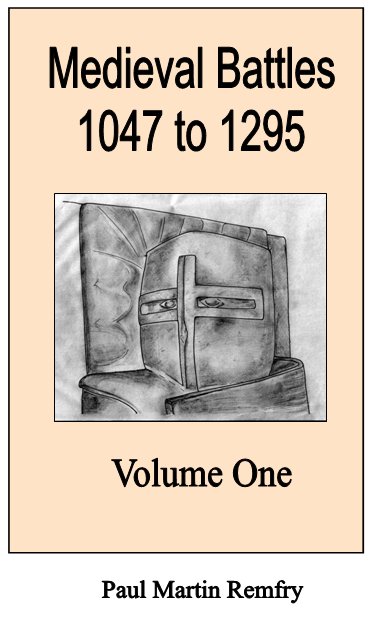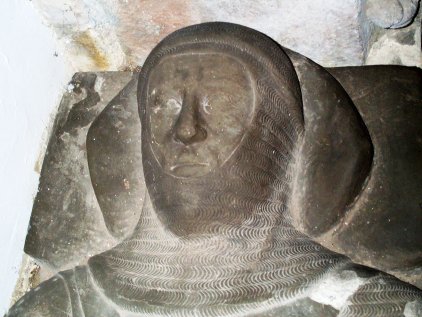When I began writing the Battles of Wales in earnest I soon realised that its scope would have to spread! This single book has now become at least five volumes. The first book in the series now commences with a general account of medieval warfare and finishes with eleven twelfth and thirteenth century campaigns which emphasise the importance of logistics in warfare. These works consist of personal translations of original documents and monuments and is intended to give a first hand account of warefare in the Middle Ages.
The following is a reproduction of part of pages 20-21 from the first volume.
If Edward I (1272-1307) was always
ready to fight to get his way, his great-grandfather, Henry II
(1154-89), was always loath to go to war. He is said to have
lamented terribly over the loss of men in battle whom he hardly
considered at all when they were alive. He appears to have
been
well aware of the consequences of battle and like many monarchs simply
preferred to avoid the uncertain arbitration of warfare. His
discussion with the cleric, Giraldus Cambrensis, is illustrative of
this reluctance and his understanding of reality. After the
fall
of Jerusalem Giraldus urged the king to join the Crusade. The
king replied,
"These clerks can summon us boldly to
arms and
dangers since they themselves will not suffer a blow in battle nor will
they undertake any burdens they can avoid".
King Henry, like other strong kings, had
a deep
feeling for his charges, the population of his territories.
He
disliked war because of the damage it caused to his people, but if
necessary he waged it with a vengeance. If Henry disliked
violence his own people and their descendants sometimes appear the
opposite. Roger Leybourne deliberately killed Arnulf Munteny,
a
household knight, at a tournament in 1252 simply because Arnulf had in
an earlier melee unseated him and broken his leg. A few years
later in the tournament of 4 June 1256 at Blyth the going got so rough
that William Longspey died soon afterwards, while Earl Roger Bigod,
Earl Roger Quincy of Winchester, Alan Watsand and John Lexington never
fully recovered as they had ‘exerted themselves beyond their
strength to such a degree that their muscles were torn and they never
afterwards recovered their health'. Such then was the fun of
the
aristocracy.
In reality the first book, which is now published, please click on the following link, Medieval Battles, 1047 to 1295, is no more than an introduction to the battles themselves which appear in the subsequent volumes. To whet the appetite the first half of the first book consists of the following chapter headings:
 The
Sources
The
Mentality of Soldiering in the Middle Ages
Description
of Cavalry, Crossbowmen, Archers and Foot
The
Accoutrements of Armour
Changing
Fashion
Cavalry,
Knights and Serjeants
Knightly
Effigies
Crossbowmen
Archers
and Foot
Siege
Engines and Engineers
Mercenaries
Trade
Tactics
and Pay
Raising
Troops
Numbers
Naval
Transport
Casualties
Supply
Movement,
Speed and Distance
Income
Wounds
The
Sources
The
Mentality of Soldiering in the Middle Ages
Description
of Cavalry, Crossbowmen, Archers and Foot
The
Accoutrements of Armour
Changing
Fashion
Cavalry,
Knights and Serjeants
Knightly
Effigies
Crossbowmen
Archers
and Foot
Siege
Engines and Engineers
Mercenaries
Trade
Tactics
and Pay
Raising
Troops
Numbers
Naval
Transport
Casualties
Supply
Movement,
Speed and Distance
Income
Wounds
Eleven campaigns are then considered:
The March to Corwen, 1165
The second book in the series is now entitled Welsh Battles, 1055 to 1295 and covers the 69 battles mentioned in historical sources between those dates. The piece I wrote several years ago for this book still stands.
Since I began studying history I realised that no true account of the many battles of the Welsh has ever been published. The nearest to a full list of actions occurs in J.E. Lloyd's seminal work of 1911, but even here many entries are brief as such a monumental history of Wales would demand. Two years ago I decided to undertake a full study of all the Welsh battles in the period between 1055 and 1295. The choice of dates was really simple. It begins with the arrival of Norman knights in Wales and ends with the defeat of the last Welsh army at the end of the turbulent thirteenth century. The battles of Owain Glyndwr belong to another period entirely when chain mail had given way to plate armour.
The book now consists of a series of chapters covering the sixty-nine battles with full descriptions with plans and photographs where available. These battles are listed below. It is hoped that such a work will fill a much needed gap in historical research and lead to a greater discussion and understanding of our military heritage.
** Glasbury, 16 June 1057 **
** Mechain, 1069 **
*** Rhymni, 1072 ***
** Dyffryn Glyncul, 1075 **
** Bron-yr-erw, 1075 **
** Camddwr, 1075 **
** Gweunytwl, 1077 **
** Pwllgwdig, 1078 **
*** Mynydd Carn, 1081 ***
** Llech-y-crau, 1090 **
** St Dogmaels, 1091 **
** Brecon, Between 17 and 23 April 1093 **
** Coedysbys, 1094 **
** Celli Tarfawg/Carnant and Aber Llech 1096 **
*** Aberlleiniog, Anglesey, May 1098 ***
** Aberystwyth, Early March 1116 **
* Ystrad Rwnws, Between May and September 1116 *
*** Maes Maen Cymro, 1118 ***
*** Wadiece, 1132 ***
** Lougher, 1 January 1136 **
** Cedweli, March 1136 **
*** Cardigan, 10 October 1136 ***
** Central Wales, 1145 **
** Coleshill, 1150 **
** Castell Hywel, 1153 **
** Tal Moelfre, May 1157 **
** Hawarden, August 1157 **
** Llanidloes, 1162 **
** Rhos y Gad near Pentraeth, 1170 **
* 'Baldert’ Bridge, 1170 *
* Elfael, 22 September 1179
* Dingestow, 1182 *
** Aber Conway, Porthaethwy and Coedaneu, 1194 **
*** Radnor, 1196 ***
*** Painscastle, 13 August 1198 ***
** Aberduhonw, Summer 1208 **
** Builth Wells, June/July 1210 **
* Cilcennin, About 30 November 1210 *
*** Llandeilo, 30 January 1213 ***
** Carmarthen Bridge, 29 August 1220 **
** Carmarthen, 26 April 1223 **
** Montgomery, May/June 1231 **
** Hay-on-Wye, July 1231 **
* Carmarthen, 1 August 1233 *
* Grosmont, 17 November 1233 *
** Monmouth, 25 November 1233 **
** Monmouth, 26 December 1233 **
*** Carmarthen, End of March 1234 ***
* Baglan, 3 or 5 February 1245 *
** Montgomery, Late February 1245 **
** Bryn Derwyn, between 24 June and 25 September 1255 **
** Berriew, Mid to Late January 1257 **
** Gwernesgof, End of May (Trinity) 1257 **
*** Cymerau, 2 June 1257 ***
* Dyfed, Monday after Easter [24 March] 1258
** Carmarthen Bridge, Mid April 1258 **
** Cilgerran, 4 or 7 September 1258 **
*** Abergavenny, 3 March 1263 ***
** Abermule, March/April 1263 **
** Brecon, 15 May 1266 **
** Glamorgan, after 13 March 1267 **
*** Llandeilo, 17 June 1282 ***
** Meol y Don, 11 November 1282 **
*** Builth Wells, 12 December 1282 ***
* Denbigh, 11 November 1294 *
*** Maes Moydog, 5 March 1295 ***
Volume 2 is now available. However due ot the amount of detail amassed for these battles it has proved necessary to devided the volume into two parts. Part 1 is now published.
Medieval Battles, Volume 2, part i, 1055 to 1216Volume 2 part ii is due to be published within the next few years as there is still much more research to be done!
The third volume is entitled English Battles, 1055 to 1266 and contains the following actions.
The fourth volume will be entitled Norman Battles, 1047 to 1214 and contain the chapters:
Val es Dunes, 1047
Arques, 1053
Mortemer, 1054
Varaville, 1057
Cassel, February 1071
Gerberoi, 1079
Tinchebrai, 1106
Alencon, 1118
Bremule, 1119
Bourtheroulde, 1124
Saint Leufroi near Evreux, 3 October 1136
Chaumont-sur-Loire, 1160
Chaumont-sur-Epte, After Apr 1167
Verneuil, 9 Aug 1173
Mirabeau, 1202
Bouvines, 20 July 1214
A final book is intended to deal with Scottish and Irish battles during this period.
For clarity these are marked as actions on a specific scale. Skirmishes or routs are marked with a star (*), battles with two stars (**), major battles with three (***) and campaigns with an X.
Since the publishing the list below I have been asked which battles are already covered in my series of booklets on castles. Links have now been established from the list below to my booklet pages and these pages have been amended to include reference to the various battles.
Paul Martin Remfry
Copyright©1994-2011 Paul Martin Remfry